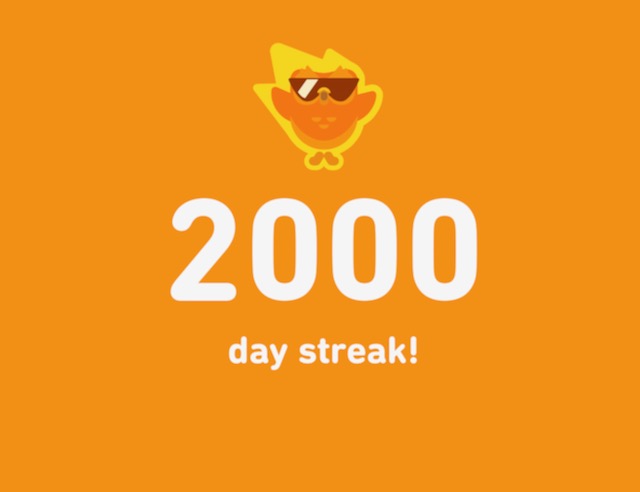I suspect that some of you will recognize the source — and perhaps the significance — of the following graphic:

The rest of you are to be commended for your wise use of discretionary time, and avoidance of activities that inevitably lead to tears of frustration and sighs of despair, much like being a Texas A&M football fan.
That character floating above the number is an owl named Duo, and it is the official mascot of the language-learning application called Duolingo. I’ve written about my experience with Duolingo before, back when I first started using it. That was about five years ago.
Which brings me to the next feature in the graphic. According to Duolingo’s records, which I’m sure are impeccable, I signed up to use the service in November, 2017 (exact date n/a). Starting within a few weeks of signing up, I’ve not failed to complete at least one lesson in 2,000 consecutive days — or, to be more precise, according to this online calculator — 5 years, 5 months, and 23 days (or 173 million seconds, which sounds even more ridiculous impressive).
I share this statistic with unequal parts of pride and embarrassment. There’s a tiny bit of pride in claiming a tiny bit of discipline to engage in an activity that has some merit, as opposed to 2,000 consecutive days of wearing the same socks. But there’s an overwhelming proportion of shame in that I’m still FAR from fluent in Spanish, despite the investment of time.
That’s not to say that I haven’t made progress. I estimate that I can read en español at about a fifth grade level, which is not nothing. I can speak with about the same fluency as a three-year-old…lots of nouns, a few less verbs and modifiers, and I can understand the spoken word with the same precision as, say, a Golden retriever (Oye, chicos…¡ustedes hablan demasiado rápido!).
Now, having confessed to my dearth of linguistic facility, I will say that both Debbie and I have been able to communicate with our beginning ESL students — all of whom are from Mexico — much better than we expected, and we’re occasionally called upon to help interpret for new students who want to enroll in classes. I’ve even learned enough to occasionally pray in Spanish (the ESL classes are held in our church, and we don’t shy away from acting out our Christian faith while being careful not to proselytize). The students have uniformly reacted favorably to that approach, by the way.
As I wrote five years ago, our bumbling attempts to speak Spanish in class have multiple benefits, not the least of which is demonstrating that if we’re not afraid to mess up in front of Spanish speakers, they shouldn’t be afraid to mess up in front of us when they attempt to speak English. It also establishes a sort of partnership arrangement whereby we try to teach each other our respective languages, although obviously our learning more Spanish takes a definite back seat to their attempts to learn English.
Duolingo is far from perfect, but I plan to keep plugging away at it. The streak itself isn’t the goal, but the discipline and the incremental benefits, not only to me but to our students, is important. Plus, I try to change my socks nearly every day.
Discover more from The Fire Ant Gazette
Subscribe to get the latest posts sent to your email.


Been there, done that Duo thing for I don’t know how long! I finally gave it up a few months ago frustrated, feeling pretty dumb until I remembered how crazy old I am. I can’t remember stuff I have to remember much less a bunch of Spanish gibberish to use on annual trips to Mexico! I may hit it again when we schedule our next trip. Ya veremos
Te escucho, hermano. At some point, motivation becomes a big factor and unless you have a specific need, it’s hard to justify the time and effort.